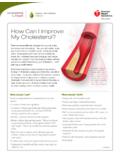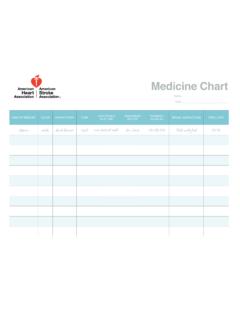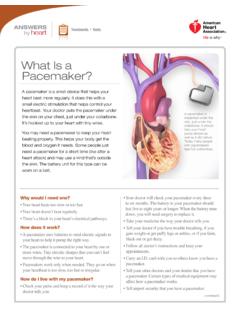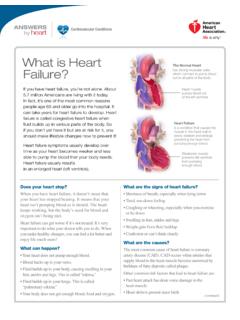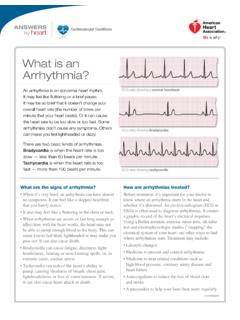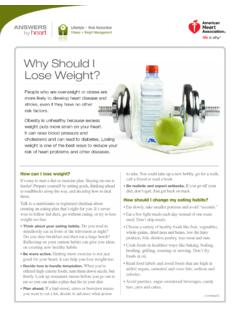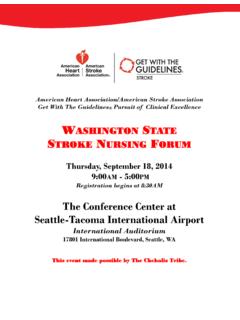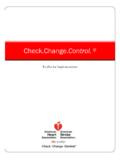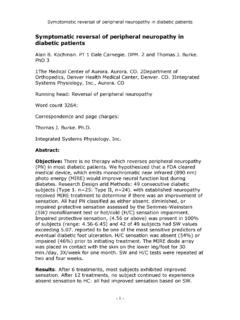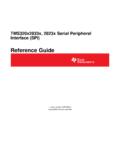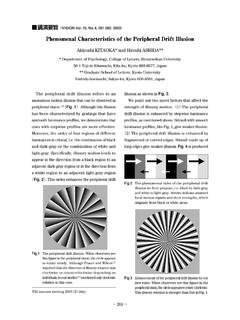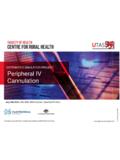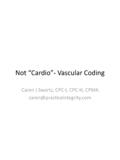Transcription of What Is Peripheral Artery Disease?
1 (continued)What Is Peripheral Artery Disease? Peripheral Artery disease (PAD) is the narrowing of the arteries to the legs, stomach, arms and head. PAD (also called PVD, or Peripheral vascular disease) is most common in the arteries in the pelvis and legs. It is a form of atherosclerosis (cholesterol build-up) caused by the collection of fatty deposits and other substances in the can be difficult to know if you have PAD. Many people with PAD have little or no symptoms. Others have pain in their legs while they walk. The pain usually goes away when they torsogroinkneeshin and calfANSWERS by heartCommon sites for PAD are the lower torso, groin, knee, and the shin and is at risk for PAD?PAD is more common as people get older. It affects about million Americans over the age of 40. And, people who smoke and those with diabetes are at especially high risk factors for PAD can't be controlled.
2 These include aging and a personal or family history of PAD, cardiovascular disease or stroke. However, you can control the following risk factors: Smoking Diabetes Overweight or obesity High cholesterol High blood pressure Physical inactivity What are the symptoms?The most common symptom is muscle cramping in the hips, thighs or calves while walking, climbing stairs or exercising. This usually goes away when the activity stops. It s called claudication. Other severe symptoms include: Leg pain that doesn t go away when you stop exercising Foot or toe wounds that won t heal or heal very slowly Gangrene, or dead tissue A mark ed decrease in the temperature of your lower leg or foot, compared to the other leg or the rest of your body Poor nail growth on the toes or hair growth on the legs Erectile dysfunction, especially in men with diabetesHow is PAD diagnosed?
3 PAD diagnosis begins with a medical history and physical exam. In the exam, your doctor can do a simple test called the ABI (ankle brachial index) that compares the blood pressure in your ankle to the blood pressure in your arms. After that, other tests may be done. They include: Toe-tip and treadmill exercise testsCardiovascular ConditionsCardiovascular ConditionsANSWERS by heartWhat Is Peripheral Artery Disease? ANSWERS by heart Doppler ultrasound MRA (magnetic resonance angiography) CTA (computed tomographic angiography) Peripheral angiogramHow is PAD treated?PAD treatment includes lifestyle changes, medicines, or both. Lifestyle changes to lower your risk include: stopping smoking controlling diabetes controlling blood pressure being physically active (including a supervised exercise program) eating a diet low in saturated and trans fatsPAD may require drug treatment, including: antiplatelet agents (aspirin and/or clopidigrel) to prevent blood clots cholesterol-lowering medicine (statins) high blood pressure medicineLifestyle changes, physical activity and medications are not enough for some people with PAD.
4 These patients may need minimally invasive treatment or surgery. Your healthcare provider will discuss your treatment options and help you choose the best one for you. Minimally invasive procedures include angioplasty and stent placement or clot removal. These are nonsurgical treatments. Angioplasty is done by making a small incision through which a thin tube (catheter) is inserted to reach the blocked Artery . A tiny balloon on the tip of the catheter is inflated inside the Artery to open the clog. A stent a tiny wire mesh cylinder may also be put in at this time. The stent acts like a scaffolding and holds the Artery open. Sometimes doctors give a medicine through the catheter or insert a special device through it to remove a clot that s blocking the a long part of an Artery is narrowed, bypass surgery may be needed. A vein from another part of the body or a synthetic blood vessel is attached above and below the blocked area to detour blood around the blocked CAN I LEARN MORE?
5 Call 1-800-AHA-USA1 (1-800-242-8721), or visit to learn more about heart disease and up to get Heart Insight, a free magazine for heart patients and their families, at Connect with others sharing similar journeys with heart disease and stroke by joining our Support Network at Do you have questions for the doctor or nurse?Take a few minutes to write your questions for the next time you see your healthcare example:Should I be checked for PAD?My Que stions: 2018, American Heart AssociationWe have many other fact sheets to help you make healthier choices to reduce your risk, manage disease or care for a loved one. Visit to learn more.
